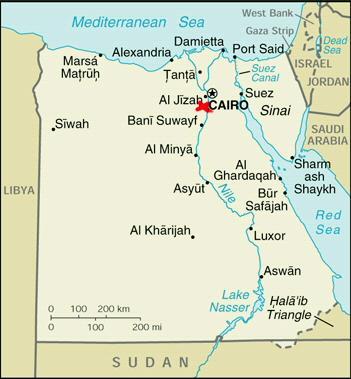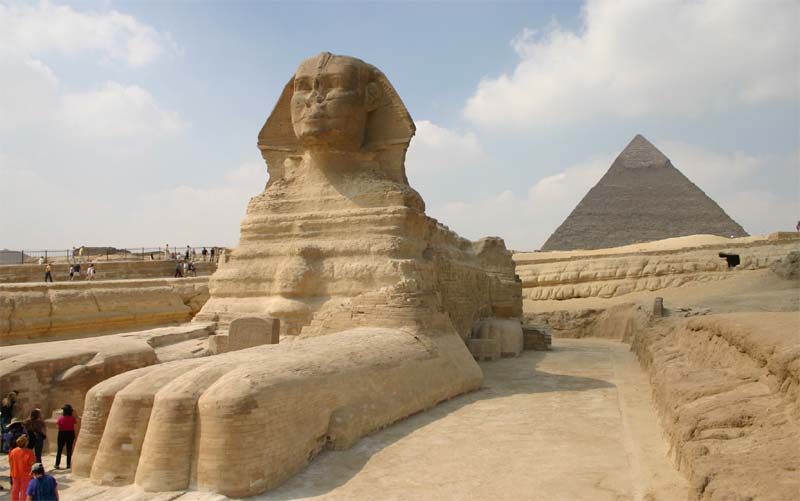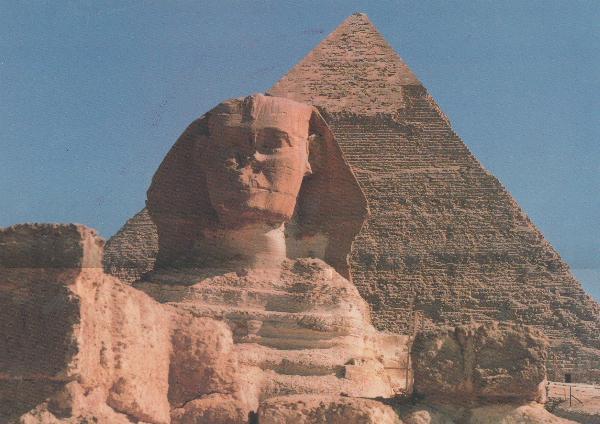 |
 |
SPHINX of GIZA - EGYPT
 |
 |
| Location: | Geographic coordinates: | Area: | Area - comparative: |
| Northern Africa, bordering the Mediterranean Sea, between Libya and the Gaza Strip | 27 00 N, 30 00 E | total: 1,001,450 sq km | slightly more than three times the size of New Mexico |
| Population: | Languages: | Capital: | Currency: |
| 69,536,644 (July 2001 est.) | Arabic (official), English and French widely understood by educated classes | Cairo | Egyptian pound (EGP) |



| Types of rocks used on the monument: | The Sphinx was carved of limestone blocks. |
The Sphinx, with its monumental proportions, lionís body, and human facial features, provides an unexpected naturalistic contrast to the geometric shapes of the pyramids. The recumbent lion stretches 241 feet/73.5 meters in length and reaches 65 feet/20 meters in height. The Sphinx was carved out of a natural outcropping of rock around the time of the construction of the Pyramid of Khafre [Chephren; c.2555-2532 B.C.E.] (to the left of the Sphinx). The features are thought to be those of King Khafre wearing the royal nemes headdress. The uraeus (rearing cobra) which originally sat on the kingís forehead is now lost, but fragments of his beard, which was added during the New Kingdom, are in the Cairo Museum.
Many of the pyramids were built with a number of different stone materials. Most of the material used was fairly rough, low grade limestone used to build the pyramid core, while fine white limestone was often employed for the outer casing as well as to cover interior walls, though pink granite was also often used on inner walls. Basalt or alabaster was not uncommon for floors, particularly in the mortuary temples and as was mudbricks to build walls within the temples (though often as not they had limestone walls). Egypt is a country rich in stone and was sometimes even referred to as the "state of stone". In particular, Egypt has a great quantity of limestone formation, which the Egyptians called "white stone", because during the Cretaceous period Egypt was covered with seawater. The country is also rich in sandstone, but it was never really used much until the New Kingdom. Limestone seems to have first been employed in the area of Saqqara, where it is of poor quality but layered in regular, strong formations as much as half a meter thick. This limestone is coarse grained with yellow to greenish gray shading. The layers are separated from each other by thin layers of clay and the coloration may vary according to layer. It could often be quarried very near the building sites, and quarries have been found at Saqqara, Giza, Dahshur and other locations. In order to quarry this stone, the blocks were marked out with just enough space in between each to allow for a small passageway for the workers to cut the blocks. The workmen would use a number of different tools to cut the blocks, including copper pickaxes and chisels, granite hammers, dolerite and other hard stone tools. The finer, white limestone employed in the pyramids and mortuary temples was not as easy to quarry, and had to be found further from the building site. One of the man sources for this limestone was the Muqattam hills on the west bank of the Nile near modern Tura and Maasara. This stone laid buried further from the surface, so tunnels had to be dug in order to reach the actual stone quarry. Sometimes these deposits were as deep as fifty meters, and huge caverns had to be built to reach the quarry. Generally, large chunks of stone were removed, and then finely cut into blocks. The blocks were then moved to the building site on large wooden sledges pulled by oxen. The path they took would be prepared with a mud layer from the Nile in order to facilitate the moving. Pink granite, basalt and alabaster were used much more sparingly. Most of this material was moved from various locations in southern Egypt by barges on the Nile. Pink granite probably most often came from the quarries around Aswan.
© Guillermo Rocha, P. G. / Brooklyn College Geology Department